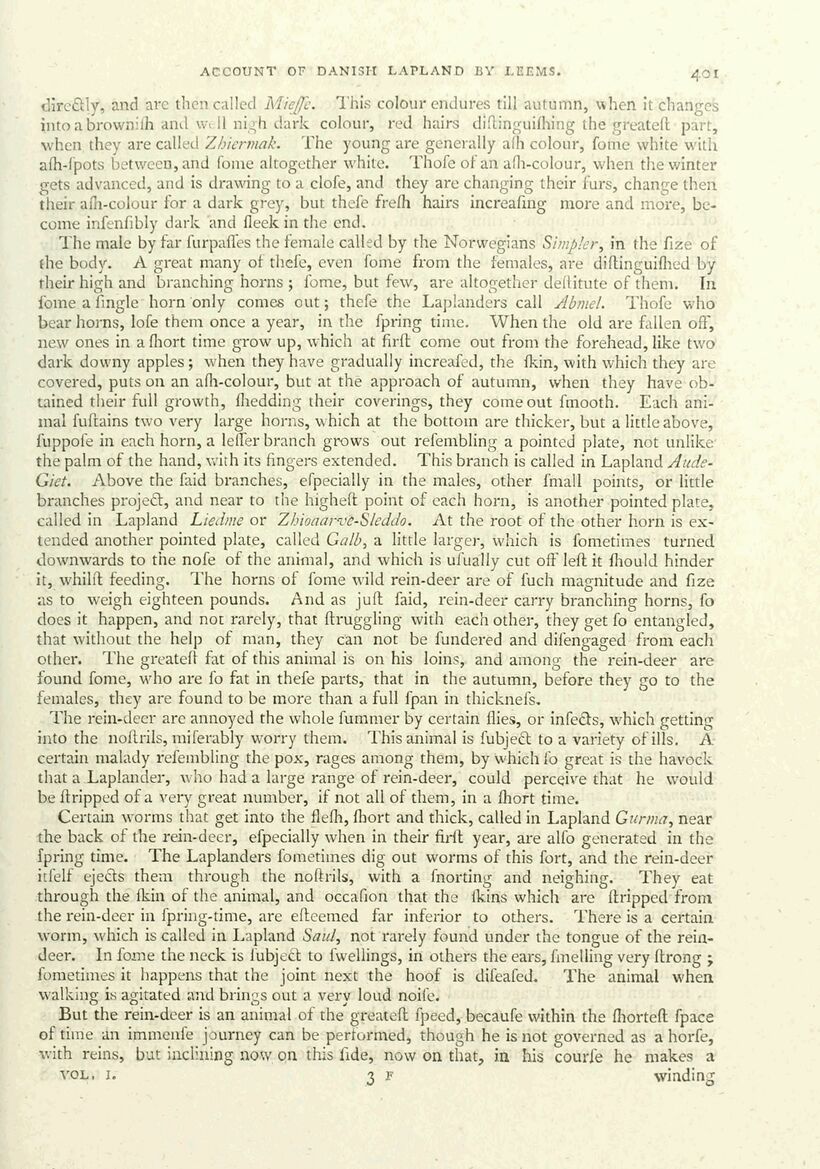
Full resolution (JPEG) - On this page / på denna sida - Pages ...

<< prev. page << föreg. sida << >> nästa sida >> next page >>
Below is the raw OCR text
from the above scanned image.
Do you see an error? Proofread the page now!
Här nedan syns maskintolkade texten från faksimilbilden ovan.
Ser du något fel? Korrekturläs sidan nu!
This page has never been proofread. / Denna sida har aldrig korrekturlästs.
ACCOUNT OF DANISH LAPLAND BY LEEMS. 4.01
dire&tly, and are then called Miefe. This colour endures till autumn, when it changes
into a brownith and well nigh dark colour, red hairs diftinguifhing the greateft part,
when they are called Zhiermak. The young are generally afh colour, fome white with
afh-{pots between, and fome altogether white. ‘Thofe of an afh-colour, when the winter
gets advanced, and is drawing to a clofe, and they are changing their furs, change then
their afh-colour for a dark grey, but thefe frefh hairs increafing more and more, be-
come infenfibly dark and fleek in the end.
The male by far furpafles the female called by the Norwegians Simp/er, in the fize of
the body. A great many of thefe, even fome from the females, are diftinguifhed by
their high and branching horns ; fome, but few, are altogether deftitute of them. In
fome a fingle horn only comes out; thefe the Laplanders call Adme/. Thofe who
bear horns, lofe them once a year, in the fpring time. When the old are fallen off,
new ones in a fhort time grow up, which at firft come out from the forehead, like two
dark downy apples; when they have gradually increafed, the fkin, with which they are
covered, puts on an afh-colour, but at the approach of autumn, when they have ob-
tained their full growth, fhedding their coverings, they come out fmooth. Each ani-
mal fuftains two very large horns, which at the bottom are thicker, but a little above,
fuppofe in each horn, a lefler branch grows out refembling a pointed plate, not unlike
the palm of the hand, with its fingers extended. This branch is called in Lapland Aude-
Giet. Above the faid branches, efpecially in the males, other fmall points, or little
branches project, and near to the higheft point of each horn, is another pointed plate,
called in Lapland Liedme or Zhioaarve-Sleddo. At the root of the other horn is ex-
tended another pointed plate, called Ga/d, a little larger, which is fometimes turned
downwards to the nofe of the animal, and which is ufually cut off left it fhould hinder
it, whilft feeding. ‘The horns of fome wild rein-deer are of fuch magnitude and fize
as to weigh eighteen pounds. And as juft faid, rein-deer carry branching horns, fo
does it happen, and not rarely, that ftruggling with each other, they get fo entangled,
that without the help of man, they can not be fundered and difengaged from each
other. The greateft fat of this animal is on his loins, and among the rein-deer are
found fome, who are fo fat in thefe parts, that in the autumn, before they go to the
females, they are found to be more than a full fpan in thicknefs.
The rein-deer are annoyed the whole fummer by certain flies, or infeéts, which getting
into the noftrils, miferably worry them. ‘This animal is fubjeét to a variety of ills, A
certain malady refembling the pox, rages among them, by which fo great is the havock
that a Laplander, who had a large range of rein-deer, could perceive that he would
be {tripped of a very great number, if not all of them, in a fhort time.
Certain worms that get into the flefh, fhort and thick, called in Lapland Gurma, near
the back of the rein-deer, efpecially when in their firft year, are alfo generated in the
{pring time. The Laplanders fometimnes dig out worms of this fort, and the rein-deer
itfelf ejects them through the noftrils, with a fnorting and neighing. They eat
through the fkin of the animal, and occafion that the {kins which are {tripped from
the rein-deer in {pring-time, are efteemed far inferior to others. There is a certain
worm, which is called in Lapland Saw, not rarely found under the tongue of the rein-
deer. In fome the neck is {ubject to {wellings, in others the ears, {melling very {trong ;
fometimes it happens that the joint next the hoof is difeafed. The animal when
walking is agitated and brings out a very loud noife.
But the rem-deer is an animal of the greateft fpeed, becaufe within the thorteft {pace
of time an immenfe journey can be performed, though he is not governed as a horfe,
with reins, but inclining now on this fide, now on that, in his courfe he makes a
VOL, I. RF winding
<< prev. page << föreg. sida << >> nästa sida >> next page >>